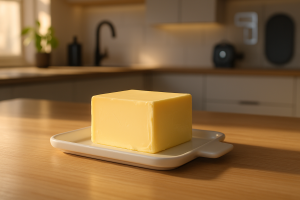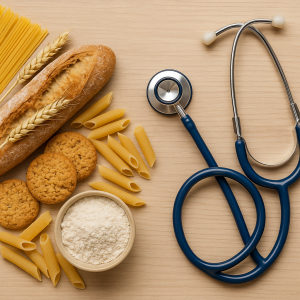Hypertension, or high blood pressure, is a serious condition
 It is often referred to as the “silent killer” because it often has no symptoms, yet it can increase the risk of heart disease and stroke, which are leading causes of death in the United States. Approximately one third of adults in the U.S. have high blood pressure. Blood pressure is measured in millimeters of mercury (mm Hg) and is composed of two numbers: the systolic blood pressure (the top number) represents the pressure in your blood vessels when your heart beats, while the diastolic blood pressure (the bottom number) represents the pressure in your blood vessels when your heart is resting between beats.
It is often referred to as the “silent killer” because it often has no symptoms, yet it can increase the risk of heart disease and stroke, which are leading causes of death in the United States. Approximately one third of adults in the U.S. have high blood pressure. Blood pressure is measured in millimeters of mercury (mm Hg) and is composed of two numbers: the systolic blood pressure (the top number) represents the pressure in your blood vessels when your heart beats, while the diastolic blood pressure (the bottom number) represents the pressure in your blood vessels when your heart is resting between beats.
Blood pressure is affected by the amount of blood your heart pumps and the resistance to blood flow in your arteries. Narrower arteries can lead to higher blood pressure. Blood pressure lower than 120/80 mm Hg is considered normal, while a reading of 130/80 mm Hg or higher is considered high. Elevated blood pressure, or readings above normal but under 130/80 mm Hg, puts you at risk for developing high blood pressure. However, making lifestyle changes can often help reduce elevated blood pressure and lower the risk of developing high blood pressure without the need for medications.
How to lower blood pressure
Increase physical activity
To lower blood pressure, it is recommended to increase physical activity and exercise more. In a 2013 study, older adults who were previously sedentary and participated in aerobic exercise training saw an average reduction in their blood pressure of 3.9% in the systolic measurement and 4.5% in the diastolic measurement. These results are similar to the effects of some blood pressure medications. Regular exercise can improve heart health by strengthening the heart and allowing it to pump blood with less effort, which reduces the pressure on the arteries and lowers blood pressure. The American College of Cardiology and the American Heart Association recommend engaging in moderate to vigorous intensity physical activity for 40 minutes, three to four times per week.
Article continued below
If finding 40 minutes at a time to exercise is difficult, there are still benefits to be gained by dividing the time into shorter segments throughout the day, such as three or four 10- to 15-minute sessions. The American College of Sports Medicine also recommends this approach. Increasing physical activity can be as simple as taking the stairs instead of the elevator, walking instead of driving, doing household chores, gardening, going for a bike ride, or playing a team sport. It is strongly recommended to engage in regular physical activity and gradually work up to at least 30 minutes of moderate intensity activity per day. Tai chi is one example of a moderate intensity activity that has been shown to significantly lower blood pressure in a 2017 review, with an average drop of 15.6 mm Hg in systolic blood pressure and a 10.7 mm Hg drop in diastolic blood pressure compared to people who did not exercise. A 2014 review on the effects of exercise on blood pressure found that several different types of exercise, including aerobic exercise, resistance training, high-intensity interval training, short bursts of exercise throughout the day, or walking 10,000 steps per day, can all lower blood pressure. Studies also continue to suggest that even light physical activity can provide benefits, particularly in older adults.
Lose weight if you are overweight
Losing even 5 to 10 pounds can significantly reduce your blood pressure and also lower your risk for other medical problems. A 2016 review of multiple studies found that weight loss diets reduced blood pressure by an average of 3.2 mm Hg in the diastolic measurement and 4.5 mm Hg in the systolic measurement.
Reduce your intake of sugar and refined carbohydrates
Many scientific studies have shown that limiting sugar and refined carbohydrates can help you lose weight and lower your blood pressure. A 2010 study compared the effects of a low-carb diet to a low-fat diet, both of which produced weight loss, but the low-carb diet was much more effective at lowering blood pressure. The low-carb diet lowered blood pressure by 4.5 mm Hg in the diastolic measurement and 5.9 mm Hg in the systolic measurement, while the low-fat diet plus a diet drug lowered blood pressure by only 0.4 mm Hg in the diastolic measurement and 1.5 mm Hg in the systolic measurement. A 2012 analysis of low-carb diets and heart disease risk found that these diets lowered blood pressure by an average of 3.10 mm Hg in the diastolic measurement and 4.81 mm Hg in the systolic measurement. A low-carb, low-sugar diet can also help you feel full for longer due to the increased intake of protein and fat.
Increase your potassium intake and reduce your sodium intake
Increasing your potassium intake and decreasing your salt intake can also help lower your blood pressure. Potassium helps to counter the effects of salt in the body and also relaxes tension in the blood vessels. However, note that diets high in potassium may be harmful for individuals with kidney disease, so always consult with a doctor before increasing potassium intake. There are many foods that are naturally high in potassium, including low-fat dairy products, fish, fruits such as bananas, apricots, avocados, and oranges, and vegetables such as sweet potatoes, potatoes, tomatoes, greens, and spinach. Note that individuals can have different responses to salt, with some being salt-sensitive (meaning that a higher salt intake increases blood pressure) and others being salt-insensitive (meaning that they can have a high salt intake without raising blood pressure). The National Institutes of Health recommends following the DASH (Dietary Approaches to Stop Hypertension) diet to reduce salt intake, which emphasizes low-sodium foods, fruits and vegetables, low-fat dairy, whole grains, fish, poultry, beans, and fewer sweets and red meats.
Eat less processed food
Most of the excess salt in your diet comes from processed foods and restaurant meals, rather than from the salt shaker at home. Processed foods high in salt include deli meats, canned soup, pizza, chips, and other snacks. Foods labeled as “low-fat” often contain added salt and sugar to compensate for the lack of fat, which gives food flavor and helps you feel full. Reducing or eliminating processed foods can help you consume less salt, sugar, and refined carbohydrates, all of which can contribute to lower blood pressure. Check labels to see how much sodium is present in a food product – according to the U.S. Food and Drug Administration, a sodium content of 5% or less is considered low, while 20% or more is considered high.
Quit smoking
Smoking causes a temporary increase in blood pressure and heart rate, and the chemicals in tobacco can also increase blood pressure over time by damaging blood vessel walls, causing inflammation, and narrowing arteries. These hardened arteries can lead to higher blood pressure. Even exposure to secondhand smoke can affect blood vessel health and increase blood pressure, as shown in a study that found children from homes with secondhand smoke had higher blood pressure than those from nonsmoking homes.
Reduce excess stress
Chronic stress can have negative impacts on health, including increasing blood pressure. Finding ways to manage and reduce stress can benefit your overall health and your blood pressure. Some effective stress-reducing techniques include deep breathing, walking, reading, watching comedy, listening to music, and using a sauna. Other options include practicing mindfulness and meditation, such as transcendental meditation, or engaging in yoga, which can involve breath control, postures, and meditation techniques. Acupuncture may also be beneficial in lowering both systolic and diastolic blood pressure.
Eat some dark chocolate
Dark chocolate that is 60 to 70% cacao has been shown to lower blood pressure. A review of studies on dark chocolate found that consuming one to two squares per day may lower the risk of heart disease by reducing blood pressure and inflammation. These benefits are thought to come from the flavonoids present in chocolate with higher cocoa solids, which help to dilate blood vessels. A study of 14,310 people found that individuals without hypertension who ate more dark chocolate had lower blood pressure overall than those who ate less.
Use medicinal herbs
Some herbs have been shown to potentially lower blood pressure, although more research is needed to determine the optimal doses and components. Be sure to check with a healthcare professional before taking herbal supplements, as they may interact with prescription medications. Some herbs that have been traditionally used to lower blood pressure include black bean, cat’s claw, celery juice, Chinese hawthorn, ginger root, giant dodder, Indian plantago, maritime pine bark, river lily, roselle, sesame oil, tomato extract, tea (especially green and oolong), umbrella tree bark, and others.
Get good, restful sleep
Your blood pressure naturally decreases during sleep, so getting enough restful sleep can help maintain healthy blood pressure. People who experience sleep deprivation, particularly those who are middle-aged, have an increased risk of high blood pressure. To improve sleep, try setting a regular sleep schedule, practicing relaxation techniques before bed, exercising during the day, avoiding daytime naps, and making the bedroom comfortable. The National Sleep Heart Health Study found that regularly sleeping less than 7 hours or more than 9 hours a night was associated with an increased prevalence of hypertension, while regularly sleeping less than 5 hours a night was linked to a significant risk of long-term hypertension.
Eat garlic or take garlic extract supplements
Garlic, whether fresh or in supplement form, is often used to lower blood pressure. One clinical study found that a time-release garlic extract may be more effective than regular garlic powder tablets. A 2012 review of studies found that a group of 87 people with high blood pressure who consumed garlic had a reduction of 6 mm Hg in diastolic pressure and a reduction of 12 mm Hg in systolic pressure, compared to those who did not receive treatment.
Consume more protein
A study conducted over a long period of time found that individuals who consumed more protein had a lower risk of developing high blood pressure. Those who ate approximately 100 grams of protein per day had a 40% lower risk of high blood pressure compared to those on a low-protein diet. Adding fiber to one’s diet also resulted in a 60% reduction in risk. However, a high-protein diet may not be suitable for everyone, particularly those with kidney disease, so it is recommended to consult with a doctor before making any significant changes to one’s diet.
Protein-rich foods include fish, eggs, poultry, beef, beans and legumes, nuts and nut butter, chickpeas, and cheese. For example, a 3.5-ounce serving of salmon contains approximately 22 grams of protein, while a 3.5-ounce serving of chicken breast contains approximately 30 grams of protein. Vegetarian options include beans and legumes, with a half-cup serving containing 7 to 10 grams of protein, and nut butter, with two tablespoons providing 8 grams of protein.
There are also several supplements that have been shown to be effective in lowering blood pressure, including omega-3 polyunsaturated fatty acids, whey protein, magnesium, Coenzyme Q10, and citrulline. In addition, reducing alcohol consumption can also lower blood pressure. It is recommended to drink in moderation, with a maximum of one drink per day for women and two drinks per day for men. A standard drink is equivalent to 12 ounces of beer, 5 ounces of wine, or 1.5 ounces of distilled spirits.
Take blood pressure lowering supplements
There are several supplements that may help lower blood pressure, including omega-3 polyunsaturated fatty acids, whey protein, magnesium, Coenzyme Q10, and citrulline. A meta-analysis of fish oil and blood pressure found that it resulted in a mean reduction in blood pressure of 4.5 mm Hg systolic and 3.0 mm Hg diastolic for those with high blood pressure. Whey protein, a protein complex derived from milk, may also have several health benefits, including the potential to lower blood pressure. Magnesium deficiency has been linked to higher blood pressure, and a meta-analysis found that magnesium supplementation resulted in a small reduction in blood pressure. Coenzyme Q10, an antioxidant, has been shown to lower systolic blood pressure by 17 mm Hg and diastolic blood pressure by up to 10 mm Hg in small studies. Oral L-citrulline, a precursor to L-arginine, may also help lower blood pressure.
Reduce alcohol consumption
It is important to consume alcohol in moderation, as it can raise blood pressure even in healthy individuals. Alcohol can increase blood pressure by 1 mm Hg for every 10 grams consumed, and a standard drink contains 14 grams of alcohol. A standard drink is equivalent to 12 ounces of beer, 5 ounces of wine, or 1.5 ounces of distilled spirits. Moderate drinking is defined as up to one drink per day for women and up to two drinks per day for men.
Be careful with caffeine
Caffeine can temporarily raise blood pressure, with the effect lasting for 45 to 60 minutes and varying from person to person. Some individuals may be more sensitive to caffeine than others, and if you are sensitive to caffeine, it may be helpful to reduce your consumption of coffee or switch to decaffeinated coffee. Research on the effects of caffeine, including its potential health benefits, is ongoing, and the decision to cut back on caffeine intake depends on a variety of individual factors. One older study suggested that caffeine has a greater effect on raising blood pressure in individuals who already have high blood pressure, but further research is needed to fully understand the relationship between caffeine and blood pressure.
Consult a doctor for prescription of medication
If you are unable to lower your blood pressure through lifestyle changes or if your blood pressure is extremely high, your doctor may suggest taking prescription medication. These medications can be effective in improving your long-term health, especially if you have other risk factors. However, finding the right combination of medications can take some time. It is necessary to discuss your options with your doctor and determine the best course of treatment for your individual needs.






